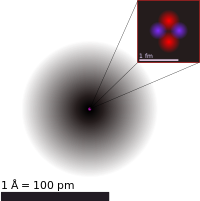
(Picture from here.)
Two Really Big Things happened recently in science. One in physics. The other in biology. We'll talk physics here today.
The physics Big Thing has to do with the composition of the universe.
Anti-matter is the opposite of normal matter. Electrons have a negative charge. Their opposite number, positrons, have a positive charge. Protons have a positive charge and anti-protons have a negative charge, etc. Anti-hydrogen would be an anti-proton with a positron shell.
When anti-matter and normal matter come into contact they annihilate one another into photons.
However, there appears to be no other difference between anti-matter and matter. The particles are of the same mass. They interact with one another in the same way. Antihydrogen and antihelium have been created and appear to be identical to their normal counterparts.
So, in the big bang why weren't there equal amounts of matter and anti-matter created? (Other than we wouldn't be here to talk about it because we would be... annihilated.)
This has been an ongoing question for a long time and is referred to as asymmetry and is considered one of the big unsolved questions in physics.
Well, some new clues came out of Fermilab recently that sheds a few photons on the problem. It turns out that there are a set of particles called B-mesons that decay into matter and anti-matter. The neutral form of these particles oscillate between a matter and anti-matter form. Depending on the point of oscillation, the particle decay into muons or anti-muons. (A muon is an elementary particle similar to an electron. It has a negative electric charge. See here.)
The B-mesons preferentially decay into muons rather than anti-muons-- a preference of about 1%. Here's another demonstrable pre-disposition towards normal matter.
It's not much. But it is interesting.
The preferences that have been described are small-- 1% isn't very much since the universe is overwhelmingly normal matter. This causes me to have the following questions:
Is this tiny preference constant? Or was there a greater preference at the moment of the big bang?
If the preference is the same, and since normal matter is overwhelmingly present, this argues there was considerably more mass at the time of the Big Bang that was subsequently annihilated. Can that energy be accounted for?
Where is dark matter in all of this? Is there a normal/anti- form of dark matter or does it not have this sort of interaction?
Isn't physics fun?
Further links:
BBC
Nobel Intent
=========================================
Wall of Idiots
Wall Street Banks
Glenn Beck
Teacher, Center High School, Alabama
Links of Interest
English-Russia
Mechanical swallowtail butterfly
Solar sails
Artificial life. And here. And here.
V: Human industrial palace in action
Llyn Foulkes: One Man's Band
Billboard stop action animation
DIY
PVC didgeridoos
Upside down tomato planter
Old window greenhouse
Pringles wind turbine
Solar thermal collector
Saving energy
Sun jar
Solar panels
Bike generator
Water flow sensor
Eco-friendly living room lamp
Power generating wind turbine
Solar PV tracker
Pulse oximeter



No comments:
Post a Comment